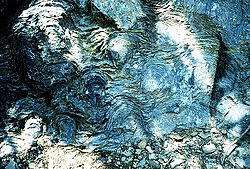
In the natural sciences, abiogenesis is either the concept that life on Earth arose from inanimate matter, or the study thereof. It also has a now outdated meaning akin to spontaneous generation. The theory of abiogenesis states that life originated through the 'evolution' of complex molecules (so-called "chemical evolution"). Amino acids, often called "the building blocks of life", occur naturally, due to chemical reactions unrelated to life. In all living things, these amino acids are organized into proteins, and the construction of these proteins is mediated by nucleic acids. Thus the question of how life on Earth originated is a question of how the first nucleic acids arose.
Some facts about the origin of life are well understood, others are still the subject of current research. The first living things on Earth are thought to be single cell prokaryotes. The oldest ancient fossil microbe-like objects are dated to be 3.5 Ga (billion years old), just a few hundred million years younger than Earth itself.[1][2] By 2.4 Ga, the ratio of stable isotopes of carbon, iron and sulfur shows the action of living things on inorganic minerals and sediments[3][4] and molecular biomarkers indicate photosynthesis, demonstrating that life on Earth was widespread by this time.[5][6]
On the other hand, the exact sequence of chemical events that led to the first nucleic acids is not known. Several hypotheses about early life have been proposed, most notably the iron-sulfur world theory (metabolism without genetics) and the RNA world hypothesis (RNA life-forms).
- ^ Wilde SA, Valley JW, Peck WH, Graham CM (January 2001). "Evidence from detrital zircons for the existence of continental crust and oceans on the Earth 4.4 Gyr ago". Nature. 409 (6817): 175–8. doi:10.1038/35051550. PMID 11196637.
{{cite journal}}: CS1 maint: date and year (link) CS1 maint: multiple names: authors list (link) - ^ Schopf JW, Kudryavtsev AB, Agresti DG, Wdowiak TJ, Czaja AD (March 2002). "Laser--Raman imagery of Earth's earliest fossils". Nature. 416 (6876): 73–6. doi:10.1038/416073a. PMID 11882894.
{{cite journal}}: CS1 maint: date and year (link) CS1 maint: multiple names: authors list (link) - ^ Hayes, John M.; Waldbauer, Jacob R. (2006). "The carbon cycle and associated redox processes through time". Phil. Trans. R. Soc. B. 361 (1470): 931–950. doi:10.1098/rstb.2006.1840. PMC 1578725. PMID 16754608.
{{cite journal}}: CS1 maint: date and year (link) - ^ Archer, Corey; Vance, Derek (2006). "Coupled Fe and S isotope evidence for Archean microbial Fe(III) and sulfate reduction". Geology. 34 (3): 153–156. doi:10.1130/G22067.1.
{{cite journal}}: CS1 maint: date and year (link) - ^ Cavalier-Smith, Thomas; Brasier, Martin; Embley, T. Martin (2006). "Introduction: how and when did microbes change the world?". Phil. Trans. R. Soc. B. 361 (1470): 845–850. doi:10.1098/rstb.2006.1847. PMC 1626534. PMID 16754602.
{{cite journal}}: CS1 maint: date and year (link) - ^ Summons, Roger E.; Bradley, Alexander S.; Jahnke, Linda L.; Waldbauer, Jacob R. (2006). "Steroids, triterpenoids and molecular oxygen". Phil. Trans. R. Soc. B. 361 (1470): 951–968. doi:10.1098/rstb.2006.1837. PMC 1578733. PMID 16754609.
{{cite journal}}: CS1 maint: date and year (link)